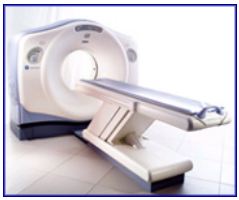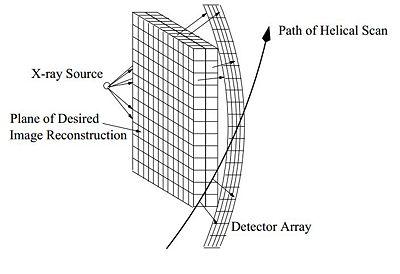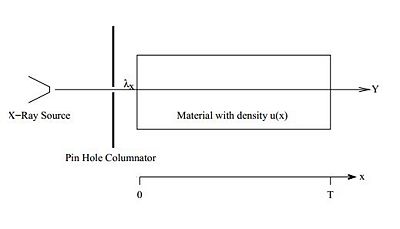| Line 46: | Line 46: | ||
| − | [[Image:CT_fig1.jpeg|700px|thumb|left|A CT scanner]] | + | [[Image:CT_fig1.jpeg|700px|thumb|left|Fig 1: A CT scanner]] |
Figure 1 shows a CT scanner for medical imaging. The patient lies down on the bed which is then translated through the scanner. The gantry is equipped with an X-ray source across from a detector array behind a fiberglass cover. The rays have a cone-beam structure. Figure 2 shows the orientation of the source and the detector array relative to the object being scanned. As the bed passes the rotating gantry, multiple data scans are collected and processed in real time. The path traced by the gantry relative to the patient is helical, hence the term helical multislice scan CT. | Figure 1 shows a CT scanner for medical imaging. The patient lies down on the bed which is then translated through the scanner. The gantry is equipped with an X-ray source across from a detector array behind a fiberglass cover. The rays have a cone-beam structure. Figure 2 shows the orientation of the source and the detector array relative to the object being scanned. As the bed passes the rotating gantry, multiple data scans are collected and processed in real time. The path traced by the gantry relative to the patient is helical, hence the term helical multislice scan CT. | ||
| − | [[Image:CT_fig2.jpeg|400px|thumb|left|Multislice helical scan CT]] | + | [[Image:CT_fig2.jpeg|400px|thumb|left|Fig 2: Multislice helical scan CT]] |
| Line 61: | Line 61: | ||
So under these assumptions, a photon that emerges from the source either stops or goes on its way to the detector array without hindrance. | So under these assumptions, a photon that emerges from the source either stops or goes on its way to the detector array without hindrance. | ||
| + | |||
| + | The X-rays emitted by the source are focused using a pinhole collimator. This is similar to how light rays are focused by a lens but the wavelength of X-rays is so short that a diffraction effects are negligible and the pinhole is sufficient for focusing the X-rays reasonably accurately in terms of physical distances. So we can assume that the X-rays emerging from the pinhole travel in a straight line. | ||
| + | |||
| + | [[Image:CT_fig3.jpeg|400px|thumb|left|Fig 3: Multislice helical scan CT]] | ||
| + | |||
| + | |||
| + | Let <math>x</math> be the depth into the material measured in cm. | ||
| + | |||
| + | Let <math>Y_x</math> be the number of photons at depth <math>x</math>. | ||
| + | |||
| + | Let <math>\lambda_x = E[Y_x]</math> be the expectation of the number of photons at depth <math>x</math>. | ||
| + | |||
| + | The number of photons at depth <math>x</math> can be modeled as a Poisson random variable. | ||
| + | |||
| + | <math>P\{Y_x = k\} = \frac{e^{-\lambda_x}\lambda_x^k}{k!}</math> | ||
| + | |||
| + | where <math>P\{Y_x = k\}</math> is the probability that there are <math>k</math> photons at depth <math>x</math> cm. | ||
| + | |||
| + | let the density of the material to be scanned be <math>\mu (x)</math> | ||
| + | |||
| + | |||
| + | |||
| + | From Beers law for the attenuation of a photon. | ||
| + | |||
| + | Poisson distribution | ||
| + | |||
| + | differential equation for attenuation | ||
| + | |||
| + | Estimate of photon integral | ||
| + | |||
| + | Once the integral is obtained, the next step would be to reconstruct the three dimensional representation using convolution back projection. | ||
| + | ---- | ||
| + | |||
| + | == References == | ||
| + | |||
| + | * C. A. Bouman. ECE 637. Class Lecture. Digital Image Processing I. Faculty of Electrical Engineering, Purdue University. Spring 2013. | ||
| + | |||
| + | References for beers law and Compton shift | ||
| + | |||
| + | ---- | ||
| + | |||
| + | ==[[Talk:ECE637_tomographic_reconstruction_CT_S13_mhossain|Questions and comments]]== | ||
| + | |||
| + | If you have any questions, comments, etc. please post them on [[ECE637_tomographic_reconstruction_CT_S13_mhossain|this page]] | ||
| + | |||
| + | |||
| + | ---- | ||
| + | [[ECE637_Bouman_lectures_Image_Processing_sLecture_mhossain|Back to the "Bouman Lectures on Image Processing" by Maliha Hossain]] | ||
Revision as of 09:51, 7 May 2013
The Bouman Lectures on Image Processing
A sLecture by Maliha Hossain
Subtopic 2: Computed Tomography (CT)
© 2013
Contents
Excerpt from Prof. Bouman's Lecture
Accompanying Lecture Notes
Computed Tomography or CT is an imaging technique that uses an X-ray source and an array of detectors to produce tomographic images of an object. CT is commonly used in medical imaging for diagnosis. It also has applications in industry for imaging internal and external components. CT is also used in airport security.
In this set of notes, we will cover the basics of the physical design of CT scanners and derive the differential equation needed for the inversion process using convolution back projection.
Physical Design
Figure 1 shows a CT scanner for medical imaging. The patient lies down on the bed which is then translated through the scanner. The gantry is equipped with an X-ray source across from a detector array behind a fiberglass cover. The rays have a cone-beam structure. Figure 2 shows the orientation of the source and the detector array relative to the object being scanned. As the bed passes the rotating gantry, multiple data scans are collected and processed in real time. The path traced by the gantry relative to the patient is helical, hence the term helical multislice scan CT.
Photon Attenuation
During a CT scan, the X-ray source emits photons that travel in a straight line towards the detectors. With each increment of distance traveled, there is a probability that a photon is either absorbed or able to reach the detector array. This is of course an approximation. When we say that a photon is absorbed, what we really mean is that it is scattered. When a photon collides with a particle, its direction changes and its wavelength increases. It is assumed that the resulting energy loss is large enough so that the detector array is no longer sensitive to it. These scattered photons eventually turn into heat that is absorbed by its surroundings.
So under these assumptions, a photon that emerges from the source either stops or goes on its way to the detector array without hindrance.
The X-rays emitted by the source are focused using a pinhole collimator. This is similar to how light rays are focused by a lens but the wavelength of X-rays is so short that a diffraction effects are negligible and the pinhole is sufficient for focusing the X-rays reasonably accurately in terms of physical distances. So we can assume that the X-rays emerging from the pinhole travel in a straight line.
Let $ x $ be the depth into the material measured in cm.
Let $ Y_x $ be the number of photons at depth $ x $.
Let $ \lambda_x = E[Y_x] $ be the expectation of the number of photons at depth $ x $.
The number of photons at depth $ x $ can be modeled as a Poisson random variable.
$ P\{Y_x = k\} = \frac{e^{-\lambda_x}\lambda_x^k}{k!} $
where $ P\{Y_x = k\} $ is the probability that there are $ k $ photons at depth $ x $ cm.
let the density of the material to be scanned be $ \mu (x) $
From Beers law for the attenuation of a photon.
Poisson distribution
differential equation for attenuation
Estimate of photon integral
Once the integral is obtained, the next step would be to reconstruct the three dimensional representation using convolution back projection.
References
- C. A. Bouman. ECE 637. Class Lecture. Digital Image Processing I. Faculty of Electrical Engineering, Purdue University. Spring 2013.
References for beers law and Compton shift
Questions and comments
If you have any questions, comments, etc. please post them on this page
Back to the "Bouman Lectures on Image Processing" by Maliha Hossain




